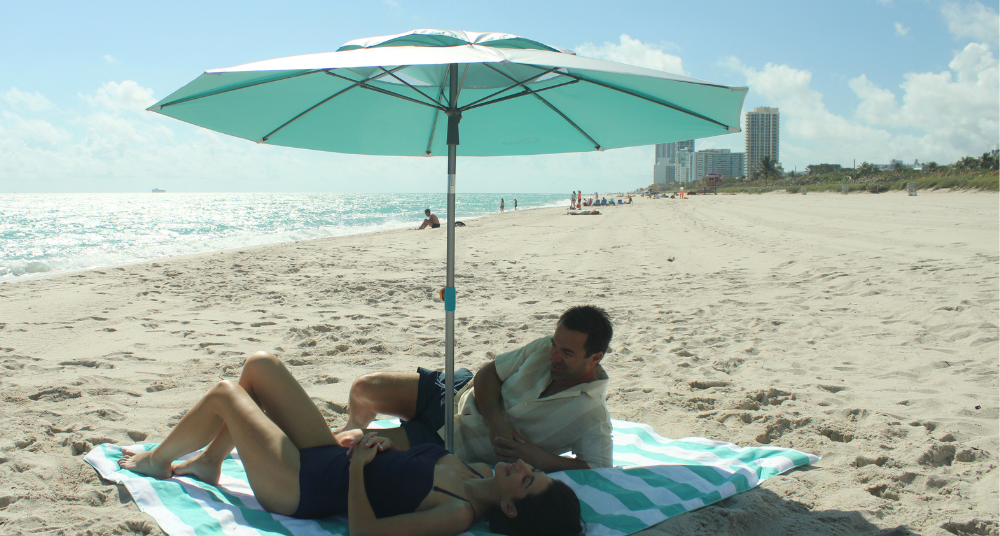Editor's Note: This is a deep dive on anchor systems. For our complete guide on the 6 key features of a wind-resistant umbrella, check out our new Ultimate Beach Umbrella Buying Guide.
By Agnes, Co-Founder of Handy Beach Goods
The beach is perfect for relaxation—until your umbrella starts walking down the shoreline. A good sand anchor keeps shade planted so you can actually relax. If you want a beach umbrella that won’t blow away, start with the right anchor and setup. For safety fundamentals (CPSC tips, ASTM context), see our Beach Umbrella Wind Safety Guide.
30-second takeaway: Choose a hammer-in sand anchor that sets deep and fast (not twist-only). Prioritize durable materials and a tool-free setup you’ll do right every time. Prefer products independently tested to ASTM F3681-24. The Handy Beach Anchor offers a deep, ~10-second set, is independently tested, and fits most 1.1" (28 mm) poles.
What to Consider Before You Buy
Depth, materials, setup speed, sand type, fit, and independent testing matter more than marketing names.
Sand Conditions
Many anchors only bite in moist/packed sand. If your beach is often dry and sugary, you need an anchor that penetrates deeper and grips better.
Anchor Depth
Deeper set = more hold. Short add-ons tend to slip/spin in dry sand.
Materials
All-metal designs resist flex and fatigue; thin plastics can crack after a few outings.
Setup Speed
If it’s slow or fiddly, you’ll cut corners—exactly when wind shows up.
Fit/Compatibility
Most consumer umbrellas use ~1.1" (28 mm) poles. See fit notes on the Handy Beach Anchor page.
Independent Testing
Look for anchors/umbrella systems independently tested to ASTM F3681-24 so performance isn’t just a claim.
Anchor Types Compared (Pros & Cons)
Know when each style works—and when it doesn’t.
1. Screw / Auger / Spiral Add-ons
- Pros: Light, inexpensive, easy to pack.
- Cons: Often short; can slip/spin in dry sugar sand; plastic parts may crack; twist-in is slower.
- Best for: Small canopies in firmer/packed sand and light breeze. (If you use one, follow the steps in our Wind Safety Guide).
2. Sandbag Bases
- Pros: Added mass can hold better than short augers.
- Cons: Dig/fill/empty each use; extra parts to carry; bulky when wet; some beaches restrict bulky/tethered setups—check local rules (e.g., Myrtle Beach).
- Best for: All-day camps when you don’t mind extra steps.
3. Integrated Deep-Set Anchors (Hammer-in)
- Pros: Purpose-built depth and grip; ~10-second setup; fewer loose parts; reliable across changing sand conditions.
- Cons: Heavier than plastic add-ons; confirm pole compatibility.
- Best for: Real coastal wind and set-and-forget shade.
Will It Fit? (A Simple Pole Measurement)
Most umbrellas are ~1.1" (28 mm) outer diameter—measure yours to be sure.
- Use a tape measure across the outside of the pole.
- If you’re between sizes, check your canopy’s spec sheet or product page.
- Our Handy Beach Anchor is designed for 1.1" (28 mm) canopies.
Shopping for a full setup? See the Handy Beach Umbrella & Anchor System.
How to Install Your Anchor in 10 Seconds
Seat it deep, keep it vertical, and angle the canopy into the wind.
- Place the anchor where you’ll sit; drive it straight down until seated deep.
- Slide in the canopy pole and tighten the knob.
- Open the canopy and angle into the wind so gusts spill, not lift.
- Re-check joints after the first gusts; lower/close in strong or shifting winds.
For full safety context and CPSC tips, see our Wind Safety Guide.
How to Care for Your Anchor
Rinse after salt, dry before storing, and keep the kit simple.
- Quick fresh-water rinse after salty days; dry fully before storage.
- Inspect the nose and joints at the start of the season.
Why We Recommend the Handy Beach Anchor
Deep, fast, independently tested—built for real beaches, not just brochures.
- Deep, Secure Set—Fast: Combined base pole + anchor; ~10-second install.
- Independently Tested: Aligned with ASTM F3681-24 for beach umbrellas and anchor devices.
- Built for Real Beaches: Non-corrosive steel nose grips dry sugar sand and penetrates compacted/pebbly patches; all-metal durability.
- Fits Most: Designed for 1.1" (28 mm) canopies. Want the all-in-one? Handy Beach Umbrella & Anchor System.
Shopping Checklist (Screenshot This)
- ✅ Deep-setting, hammer-in sand anchor (not twist-only)
- ✅ All-metal construction for strength and longevity
- ✅ Tool-free, ~10-second setup you’ll actually do right
- ✅ Works in dry sugar sand and compacted areas
- ✅ Independently tested to ASTM F3681-24
- ✅ Fits standard 1.1" (28 mm) umbrella poles
Frequently Asked Questions (FAQs)
What’s the best beach umbrella anchor for wind?
A deep-setting, hammer-in sand anchor you can seat in seconds and that’s independently tested to ASTM F3681-24. Depth + fast, foolproof setup beat twist-only augers—especially on dry sugar sand.
Auger/spiral vs hammer-in: which holds better in dry sand?
Twist-in augers are short and can slip/spin in dry sugar sand. A hammer-in, deep-set anchor bites deeper and holds more consistently across changing conditions—so you’re not chasing your shade.
Are sandbag bases more reliable than anchors?
A well-designed sandbag base can be very stable (some are independently tested), but they’re slower and messier and add parts to carry. A hammer-in anchor offers comparable hold with faster, simpler setup—no sandbags to manage.
Will the Handy Beach Anchor fit my umbrella?
Most likely. It’s designed as a base pole and fits standard canopies with a 1.1" (28 mm) pole diameter. If unsure, measure across the outside of your pole.
Is any beach umbrella or anchor truly windproof?
No. Always follow the manufacturer’s setup and safety instructions—seat the anchor fully, angle into the wind, tighten joints, and lower/close the umbrella when conditions change.
Final Takeaway
Short augers are convenient, sandbags can work but are fussy, and deep-set hammer-in anchors are the most reliable across real beach conditions. The Handy Beach Anchor hits the checklist: fast setup, deep hold, durable materials, compatibility, and independent ASTM-aligned testing—so you can relax and keep your shade where it belongs.
A Final Safety Note
No shade system is truly windproof. Always follow the manufacturer’s setup and safety instructions (see CPSC beach umbrella safety tips) and lower or close the umbrella in strong or shifting winds.
About the Author
Written by Agnes, co-founder of Handy Beach Goods and a Florida mom of two. After one too many runaway umbrellas, she set out to design anchors and umbrellas that actually stay put—engineered for real coastal wind and made with planet-kind materials.



